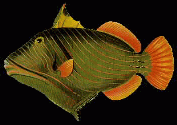

We will be discussing many topics this term, from many points of reference. Give these questions some thought. By the end of the course you will be familiar with their answers:
1. Which are more closely related: a trout and a lungfish, a trout
and a cow, a cow and a lungfish? What does 'related' mean? Why
are the Agnatha and Cyclostomata misleading and inappropriate
for any legitimate evolutionary study?
2. What does the term craniate mean? What does the term salmoniform
mean? Might there be different meanings to these terms?
3. There is a large group of surgeonfishes in the Pacific Ocean.
In many species, juveniles are yellow, but adults of various colors,
striped, etc. Some scientists contend that the yellow of juveniles
is an important adaptation, and that it is so important that it
has arisen many times in the evolution of these surgeonfishes.
Others contend that the yellow coloration originated millions
of years ago, once, in the ancestor of all the recent surgeonfishes,
and that there may be no need to posit an adaptive explanation
in its origin. How can you test these hypotheses? What is the
hypothesis?
4. Is there any pattern of morphological and behavioral change
in fish feeding mechanisms that supports a notion that evolution
can proceed by the integration of old parts into new functions?
5. How can a fish that was born in a clear, fresh-water mountain
stream survive transition to a life in the sea?
6. Lungs are for breathing?
7. What kind of fish can have its love life interrupted by a lightning
storm?
8. Do fishes smell? How can you tell?
9. Do fishes taste? How can you tell?
10. Is it possible to think of a way to reproduce that is not
done by at least some fishes?
11. There is a wonderful fish in the Mississippi River, the paddlefish.
Its closest living relative is in the Yellow River of China. What
does this tell us about the past?
12. There are some deep-sea fishes that move up towards the surface
at night and then back down to depths during the day. Why would
they do that? Also, these fishes have light organs that help to
camaflouge them--how do they match their own lights to the intensity
of light around them?
13. In some places in South America, the local people will tell
you not to urinate in the water during your morning dip. Why?
14. You are on a vacation in the Bahamas. At lunch you are offered
a choice of sandwiches made of moray eel, barracuda, or mullet.
Which do you choose and why?